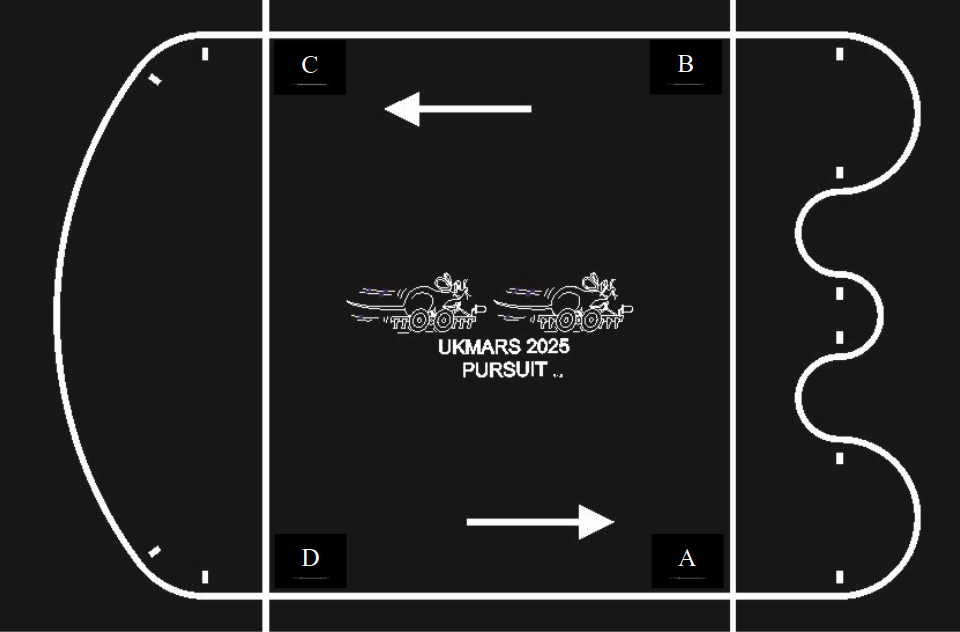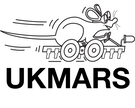Skip to content
DRAFT
UKMARS Pursuit Competition Rules version 1.0
A. Generic Micromouse Pursuit Competition Rules
- These rules can be applied to Line- or Wall- Following in both standard and half size variants.
- The nature of the competition is that two mice compete on a closed course at the same time. The mice start at opposite points on the course and each tries to catch the other mouse. The course is divided into four sections. If a mouse catches up its opponent sufficiently so that both mice are in the same section the faster mouse is deemed to have won, the race is stopped and the slower mouse is eliminated from the competition.
- The winner of each race stays on the course and goes forward into the next round where it meets the next contestant. Rounds continue until all mice have raced and the winner of the final round is the champion.
- All the standard rules regarding course and robot design apply. So, in the case of Line Followers, the mouse size, line width, minimum curve radius, marker positioning etc. apply.
- There are no special features to identify the start and end of the course. The start/finish markers for Line Following are not present. The mice should go round the course an indefinite number of times.
- The course may not cross over itself. This would present a crash hazard.
- There is a specific modification to the rules:
- Handlers may interact with the mouse in any way. Specifically remote control is permitted.
- Handlers may touch their mouse during competition.
- Putting the mouse back on the line or freeing it from being jammed up against a wall is permitted.
- The mouse must not gain from a touch and the Judge’s decision on this matter will be final.
- If the touch causes the timing gear to have a problem, that mouse is disqualified.
B. Competition administration
- The Judges will determine the running order. As much as possible, slower mice will run earlier in the competition. The running order will be available to all contestants from the start of the competition.
- At the start of each round, the contestants have a 30 second countdown. Handlers can use this time to prepare. At the end of this period there will be a variable delay before the “GO” signal and the race starts. If the mouse crosses the start line between the end of the countdown and the “GO” signal it is disqualified.
- Mice circulate until either one has caught up or two minutes have elapsed. After the two minutes, the mouse which was ahead the last time it crossed its start line is the winner.
- The winner goes forward to the next round. The handler may make any changes, e.g. new
batteries, during the 30 second pause before the next round. The next race starts 30 seconds after the previous race finished. Mice must be ready to run even if a race only lasts a few seconds.
- The loser of the penultimate race will be awarded third place, the loser of the last race will be awarded second place.
C. Detailed description of a Line Follower Competition.

- This is a typical Line Following Pursuit course. The crossover points, A, B, C, D, are the
positions of the timing gear. The line sections are AB, BC, CD, and DA.
- The two mice are referred to as RED and BLUE. The RED mouse starts in the segment DA. The BLUE mouse starts in the segment BC. For the first race, contestants may agree which mouse runs on which side or the Judges will give a ruling. The winner of the previous race chooses which start line they wish to use for the next race.
- There is a 30 second countdown period before a race. During this preparation period handlers may make any changes to their mice. In particular batteries, tyres and software may be changed. However, the complete mouse may not be substituted. The judges will decide if this has happened. If in doubt, consult with the judges beforehand.
- After the countdown period a mouse will be disqualified if it triggers the timing gear at point A
or C before the GO instruction.
- The Judges will issue a GO instruction after a variable delay and the mice may start. Handlers may place temporary start/finish markers in their start section but must remove them before their opponents reach this section. This allows unmodified Line Followers to enter. If neither mouse is ready, both are disqualified and the next two mice will run after a further 30 second preparation period.
- It is vital that mice are ready to race at 30 seconds notice during the whole event. The
competition is intended to be pacey with maximum spectator appeal.
- Once a mouse triggers the timing gear at point A it is considered to be in section AB. Once it
triggers the timing gear at B it is considered to be in section BC. Once it triggers the timing gear
at C it is considered to be in section CD. Once it triggers the timing gear at D it is considered to
be in section DA.
- During the race the handlers may interact with their mice. Remote control is permitted. Remote adjustment of speed settings, control constants, etc. is permitted.
- Handlers may touch their mouse. In particular, if the mouse leaves the line, the handler may pick it up and return it to the line at a point before it happened. However, the mouse must not cross a timing point out of sequence as this could disrupt the timing system. In no circumstances may the mouse gain an advantage by being handled. The judges will disqualify entrants who gain an advantage even if it is inadvertent.
- The timing gear maintains information concerning which section each mouse is in. If both mice are in the same section, the mouse which entered the section later is declared the winner. This is called a “catch up”.
- If there is no catch up at the end of two minutes, the times at which the RED mouse entered
section AB most recently and the BLUE mouse entered section CD most recently are compared
and the winner is the mouse that entered the relevant section first.
- At all times and especially after the winner has been declared both handlers are responsible for preventing collisions. Handlers may request other people to handle their mouse to help prevent collisions. Failure to prevent a collision may result in disqualification at the judges’ discretion.
- The 30 second countdown for the next race starts as soon as the winner of a race has been
declared.

